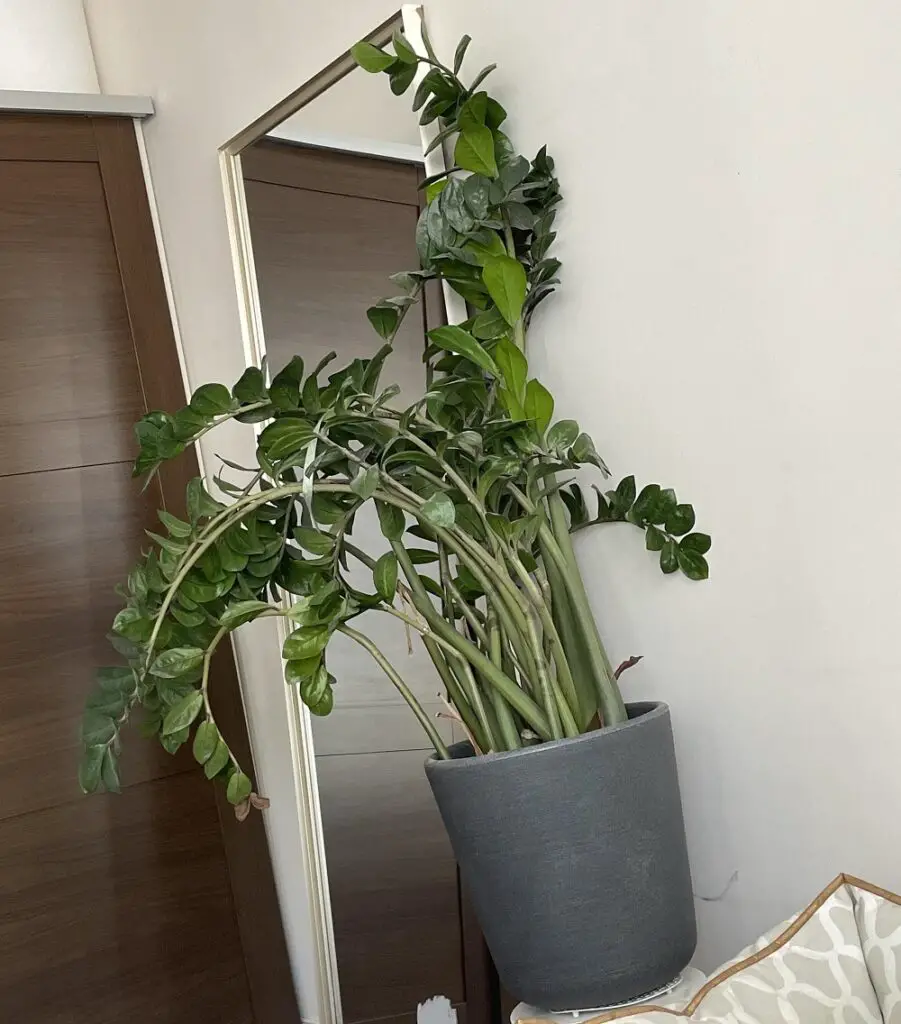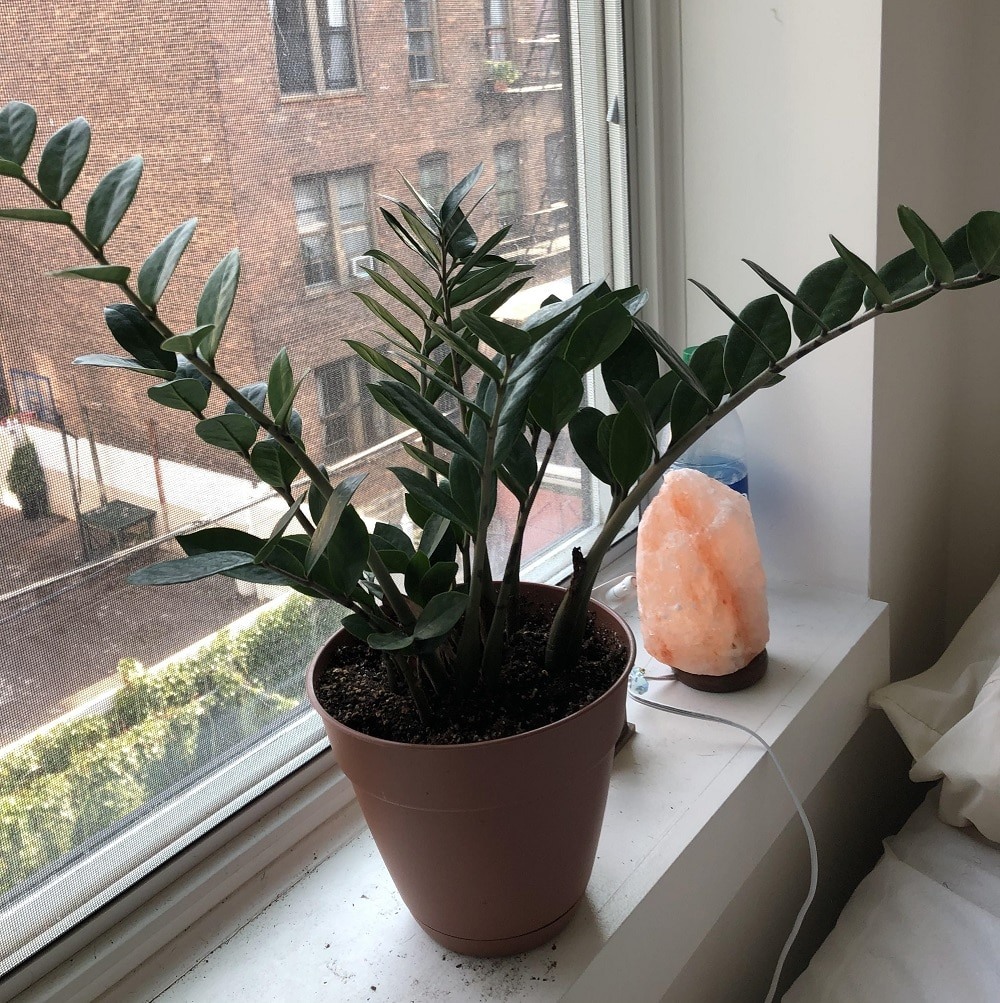ZZ plants are hardy and an incredible option for novice houseplant parents. These indoor plants require minimal care regime and can tolerate months of neglect without becoming fussy.
The ZZ plant drooping is an inevitable problem. Every houseplant enthusiast will have to battle with the issue once in their lifetime.
So, why are my ZZ plant stalks falling over? ZZ plant stems droop or fall over due to inappropriate watering, over-fertilization, lighting problems, transplant shock, and cold drafts.
The rule of thumb is to identify the exact cause to help in preventing the ZZ plant stems from falling over. There are several solutions ideal for fixing the problem.
Keep reading this article to learn how to stop your ZZ plant stalks from drooping. The information will also help you to identify the underlying problems.
You May Also Like:

Reasons Why ZZ Plant Stems Are Falling Over (And How to Fix)
There are several reasons why your ZZ plant stalks fall over. Below are the most common reasons for the ZZ plant not growing straight (Source: University of Illinois):
Overwatered ZZ Plant
ZZ plants are types of succulents native to East Africa (Kenya and Rwanda). These plants have semi-arid features that allow them to tolerate months of neglect without dying.
The rhizome root systems also allow the plant to cope with a sporadic downpour and hold adequate water for survival.
But overwatering can cause the rhizomes to rot and decay. You’ll need to create more time for soil drying between the watering plans.
ZZ plant not growing straight is a sign of overwatering. Soggy soil makes it challenging for the rhizomes to absorb oxygen. It ends up creating unhealthy root systems.
The waterlogged condition also creates an environment for bacteria and fungi to thrive. These microbes later attack the roots to cause rot and decay.
Severe root rot usually results in unhealthy plants in the long run. Other signs of root rot are ZZ plant leaves turning yellow and drooping.
If you suspect the root rot issue, consider re-potting the houseplant. Uproot the plant and snip off the affected roots with a sterilized pair of scissors.
Use well-drain potting mix and a container with drainage holes at the bottom. These holes help to get rid of excess water and allow the plant to flourish.
Under-watered ZZ Plant
Under-watering is the less common cause of ZZ plants not growing straight. The houseplant can tolerate a long period of dryness without becoming fussy.
But the extreme withdrawal of the watering routine might harm your plant. The slow dehydration will make the leaves dry up, curl and fall off.
Besides that, the ZZ plant stalks will begin to bend and fall over in the long run. If the condition persists, the plant is likely to wilt and eventually die.
Fixing the under-watering problem is super easy. You’ll need to inspect the soil moisture content first before watering. It will help to reduce the risks associated with overwatering.
I usually recommend watering the plant twice or thrice a month during spring and summer. Be sure to check the soil moisture in winter before watering.
Direct Exposure to Sunlight
ZZ plants love medium to bright indirect sunlight. But this houseplant can still adapt to different conditions without its health being compromised much.
Sunlight is essential for any indoor plant. It helps plants to undertake photosynthesis and other vital physiological processes.
But extreme lighting conditions might harm your houseplant. Direct exposure to excess sunlight will make your ZZ plant stalks droop. It will also make the leaves curl and fall off.
Consider changing the current location of your plant to a region that receives medium indirect sunlight. Use curtains on the window to temper the sunlight intensity.
Low lighting condition is also not ideal for your houseplants. The ZZ plant will experience stunted growth, and the stems will become leggy as the plant try to stretch in search of more light.
I usually recommend installing LED grow lights in case the current location does not receive natural light. The technique will save your ZZ plant stems from bending.
Over-Fertilization is Harmful
Over-fertilization can cause the ZZ plant stalks to fall over. The excess salt buildup around the rhizomes inhibits the absorption of water and other vital minerals.
The excess salt in the soil usually causes dehydration. The ZZ plant will respond by drooping and curling leaves to reduce the water loss rate.
I recommend using organic fertilizer over the artificial counterpart. The compost will promote healthy growth and development of stunning foliages.
The good news is that ZZ plants are not picky when it comes to the type of fertilizer. But consider applying fertilizer during fall and summer only.
Use well-balanced water-soluble fertilizer. The nutrients will help to reduce the risks associated with stalks falling over or leaves turning yellow and brown.
Extreme Temperatures
ZZ plants prefer a temperature range of 65-75oF. This favorable temperature will allow the houseplant to thrive and make a bold statement at home.
Any temperature below 45oF can be harmful to the plant. The ZZ plant becomes vulnerable to stems falling over, leaves curling, and wilting.
Besides that, the ZZ plant stalks will turn brown and eventually break off. But the cold stress can be fixed by providing the ultimate temperature requirement.
High temperature above 75oF is also unsuitable for your ZZ plant. The excess heat will make the plant droop and leaves curl due to dehydration.
Be sure to keep the houseplant away from cold drafts and heat radiators. It will help to prevent the ZZ plant stems from falling over.
You May Also Enjoy: Why Does My ZZ Plant Have Yellow Leaves?
Transplant Shock
ZZ plants are more vulnerable to root-bound issues. You’ll be expected to re-pot the plant after a few years to prevent root-bound problems.
But the transplant process might stress your houseplant a little bit. The ZZ plant will display distress by drooping stems and leaves.
ZZ plant stalks falling over due to transplant stress should not freak you out. The stem slumping over will recover after a few days.
Be sure to water the plant and provide the ultimate ZZ plant care routine. The roots recovery will make the stalks perk up well.
ZZ Plant Stem Trauma
A ZZ plant stem falling over is a sign of physical damage to the plant. The issue is more common in homes with children and pets.
The rough treatment can also lead to stalks breaking off. Damage stems can’t recover and should be cut off from the plant using sterilized shears. (Source: University of Florida).
Frequently Asked Questions
How Do I Keep My ZZ Plant Upright?
Relocate the plant to an area that receives medium to bright indirect sunlight. The lighting condition will make the stalks grow upright.
How Do You Fix a Leaning ZZ Plant?
Rotate the plant pot more often to ensure every part receives equal sunlight exposure. The tactic will help to prevent the ZZ plant from having a lopsided look and crisscrossing stems.
How Often Should You Water ZZ Plant?
Every 2-3 weeks to allow the soil to dry out between the watering. Be sure to check the soil moisture content first before watering. Keep in mind that the plant will need more water in summer than winter.
How Long Can ZZ Plant Go without Water?
ZZ plant is super hardy and can survive in challenging conditions for a couple of months. The houseplant can live up to four months without water.
You May Also Like: Why Are My ZZ Plant Leaves Curling?

In Conclusion
ZZ plant is hardy and can cope with several months of neglect. But the ZZ plant stalks fall over is a sign of an unhappy houseplant.
Try to examine the plant and identify the exact problem. Learn how often to water the ZZ plant to avoid the issues related to watering.
ZZ plants not growing straight is due to improper watering, temperature stress, over-fertilization, physical damage, and transplant shock.
